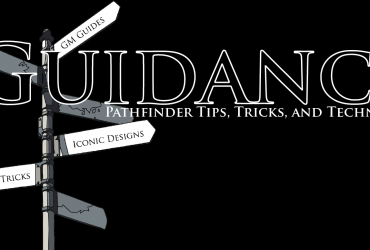Villains are one of my favorite parts of Fantasy RPGs. From scheming wizards to ruthless warlords, a good villain can motivate players more than any other single story element you can throw at them. Big Bad Evil Guys (or Girls) have been part of RPGs and indeed the stuff of stories from time immemorial. How many adventures can you recall that end with a final showdown to end the threat of a wicked and evil villain?
There’s a reason for that. It’s because villains provide a focus to a story or an adventure. Combatting an entity or an individual is far more concrete than fighting an idea or a concept. Giving the players a physical and tangible presence to menace them helps bring clarity of purpose to the PCs and can provide a ready answer to the question, “Why are we doing [this dangerous thing] again?”
But what goes into a “good” villain? How can you best create or represent (in the case of published adventures) an NPC that inspires such loathing from your PCs? There are countless guides and stepped processes out there that will help you create a realistic believable villain. But villains in traditional fiction must needs be different than villains in RPGs. Why? Because while fiction and RPG stories share many of the same elements, most works of fiction have but one author to piece together the narrative, and RPG stories have many contributors.
For this article, I’m primarily focusing on what you can do as a GM to get the most out of your villains. How you can use them and what sort responses you can expect from your players. For the purposes of this article, I’m going to assume that a villain is a primary antagonist to your PCs. He’s not entry #3 on the random encounter table. He’s the guy actively planning to rain fire and brimstone on your players’ parade.
The follow are a collection of thoughts I’ve had on villains over my years of GMing. They’re in no particular order. Although I’ve tried to organize them into coherent chunks:
A strong villain hurts
I’m not just talking about high DPR. A proper villain should provoke a strong negative emotional response from your players, whether that be hate, fear, nervousness, or a combination thereof. The easiest way to do this is to have your villain strike out at something your PCs care about. Have the villain’s thugs attack the PCs’ hometown. Or perhaps the villain has engineered the death of a PC’s loved one. Try to avoid outright displays of overwhelming power in combat. You want your PCs to feel threatened by the villain but not so afraid that they avoid confronting him.
There’s a bard in Kingmaker that’s written into the plot of the second book. This bard is a saboteur sent from a rival kingdom and is actively trying to turn the populace against the PCs. I applied a quick rewrite to the character and dealt a shocking blow to my PCs when it turned out that this bard was one of the PC’s own sister. That confrontation was brutal because that one PC refused to fight his sister but the bard and her minions had no such reservations.
Good villains aren’t stupid
This isn’t to say they can’t be tricked. But a proper villain didn’t rise to the point where they can threaten a group of PCs by being stupid or overly gullible. A good villain will some sort of plan to have gotten where they are. They are cunning, if not outright brilliant. This is one of the compelling reasons for making a BBEG a wizard or spellcaster. Because they not only have the resources to menace the PCs, they have the intelligence to best employ them.
In a fight this will likely mean that the villain should have some sort of interesting tactic that makes use of some special abilities or terrain. If they’re losing they probably have an have an escape route as well, whether mundane or magical. Which leads into the next thought…
A good villain is recurring
That’s the difference between a tough mook and a true adversary. A villain will return to menace the party again and again, if not personally than in other ways. A great example of this is the scheming wizard in a far off tower, spinning his machinations to take over the world. The PCs will encounter his thugs, be caught in his plans, and try and defeat his wards and guardians countless times before ever actually meeting him in person.
A recurring villain gives the party something to hate. He’s the carrot on the stick that make the PC-donkeys pull the narrative cart. Knowing that the next encounter with a villain might not be the last adds a layer of suspense and tension and keep your PCs on edge. A great example of this came up in my Rise of the Runelords game. The PCs came to hate a particular Lamia Matriarch by the name of Xanesha. Those of you familiar with RotR should be familiar with the name. After barely surviving the first encounter with the snake-lady, the PCs would encounter her again and again meddling in their affairs. Each confrontation would be deadlier than the one before it. The PCs grew more and more fearful and wary with every passing session. It was glorious.
No one likes beating a dead horse
Know when it’s time for a villain to bow out. A villain can sometimes be interesting enough to structure an entire campaign around. But often times a villain will outlive his usefulness after the third or fourth direct encounter. Having a villain who repeatedly gets away can be frustrating for players because it feels like they’re not actually accomplishing anything. While this can be useful in the short term, over time it can negatively impact your game.
I probably milked Xanesha too long. She showed up at the end of book two and I didn’t give my players a proper opportunity to kill her until the end of book five. By then they were absolutely sick of her. I could sense how much my players hated her. And it was hurting their enjoyment of the game overall. When the end came for poor Xanesha, it was brutal and bloody.
Finally, a good villain should directly oppose the PCs
This seems like it should be an obvious one. But in the past I’ve gotten so caught up with how awesome a villain was that I completely forgot that the story is ultimately about the PCs. If you’re thinking about creating a villain or you’re running an NPC that might become a villain, and that character’s goals don’t interfere or hinder the PCs’ activities, then your character isn’t a part of the story. Plain and simple. The narrative is about your players. Anything that deviates from this truth becomes wasted effort.
Have an awesome villain experience you want to share? Think I missed something? Let us know in the comments section below!






Leave a Reply